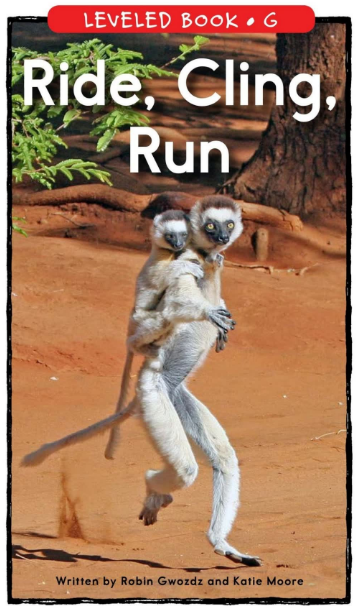适合年龄
8岁左右
绘本简介
Is it better to ride, cling, or run with your family? The book Ride, Cling, Run examines the different ways animals travel from place to place. Students have the opportunity to identify the author's purpose as well as to connect to prior knowledge. Supportive photographs, high-frequency words, and repetitive phrases support emergent readers.
和家人一起骑车、抱抱还是跑步更好?《骑行、依附、奔跑》一书考察了动物从一个地方到另一个地方旅行的不同方式。学生有机会确定作者的目的,并与先前的知识联系起来。支持性的照片、高频词和重复短语支持紧急读者。

绘本内容
Many animals travel from place to place.
They travel to find food, water, and shelter.
Baby animals often travel with their parents.
They may ride, cling, or run with their parents.
Baby lions are called cubs .
Some cubs ride in their mother’s mouth. Lions sleep in dens.
Baby fish hatch from eggs.
Some baby fish ride i n their father’s mouth. Fish live in water.
Baby spiders hatch from eggs.
Some baby spiders cling to their mother’s back. Most spiders climb on webs.
Baby frogs hatch from eggs.
Some baby frogs cling to their father’s back.
Frogs can live in water and on land.
Baby penguins hatch from eggs.
Baby penguins run behind their parents.
Penguins like to swim, but they can also run
中文翻译:
许多动物从一个地方到另一个地方旅行。
他们去寻找食物、水和住所。
小动物经常和它们的父母一起旅行。
他们可能和父母一起骑马、抱抱或跑步。
幼狮被称为幼狮。
有些幼崽骑在妈妈的嘴里。狮子睡在洞穴里。
小鱼是从蛋里孵化出来的。
一些小鱼骑在它们父亲的嘴里。鱼生活在水中。
小蜘蛛是从卵孵化出来的。
有些小蜘蛛紧贴着妈妈的背。大多数蜘蛛都会在网上爬行。
青蛙宝宝是从卵孵化出来的。
一些小青蛙依附在父亲的背上。
青蛙可以在水中和陆地上生活。
企鹅宝宝是从蛋里孵化出来的。
小企鹅跟在父母后面跑。
企鹅喜欢游泳,但他们也会跑

